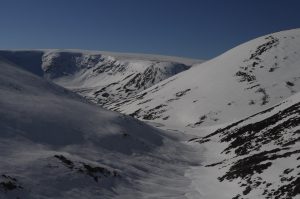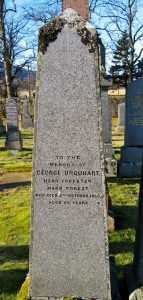Mar Lodge Estate, near Braemar on Royal Deeside has hunting associations going back over a thousand years.
It was the largest and most important deer forest in medieval Scotland and popular with several of its kings who were attracted to it for the quality and quantity of the deer.
The first owners, of whom there are records, were the Earls of Mar who are said to have held it from the time of King James IV who died at Flodden in 1513.
In 1618 a later Earl arranged a great hunt for his family and the neighbouring gentry. Scores of men and dogs drove hundreds of deer down from the surrounding hills into the Dee valley where, according to a contemporary account, “fourscore fat deere were slaine with gunnes, arrowes, durks and daggers, in the span of two hours.”
In October 1850 the Duke of Leeds rented Mar Lodge from the succeeding Earl of Fife and invited Queen Victoria, the Prince of Wales (later King Edward V11) and Prince Albert to another large drive.
A herd of 300 deer passed within a short distance of the Royal party and although it was estimated over 3,000 beasts were pushed into the glen that day, only two were shot.
The ballroom of the present Mar Lodge, now owned by the National Trust for Scotland, is lined with over 3,000 stags’ heads and sets of antlers collected on Mar over the centuries and is one of the wonders of the UK stalking world. If they could speak, each head would no doubt have an interesting story to tell – none more so than the stag that shot the man who stalked it!

In 1866 Thomas Powell, a wealthy coal mine owner from Newport, Monmouthshire, rented Mar Lodge Estate and following the custom of the day, employed his own stalkers, or foresters as they were called then. His head forester was George Urquhart.
Little is known about George’s background. He was born at Conon Bridge on August 8, 1836 to John Urquhart, wood sawyer, and Elspet Fraser, and brought up in Strathglass near Inverness.
George must have found his niche early in life as it was not long before he gained the reputation of being one of the finest hill-men around.
He came to the attention of Horatio Ross, a godson of Nelson and one of the most celebrated sportsmen of the day. Ross, too, had rented Mar Lodge from the Fife family for a number of years previously and probably recommended him to Powell.
On Friday October 5 the party, comprising Urquhart and Powell with two other foresters, John Grant and Peter Macintyre, set off up Glen Geusachan to stalk the face of Cairntoul – one of the highest hills in the Grampian range to the north of the lodge.
About two o’clock in the afternoon Powell shot at and wounded a stag which ran towards the boundary of the neighbouring Glenfeshie estate. Urquhart took the rifle – a double-barrelled weapon – from Powell and along with Grant, followed the stag in an attempt to head it off. He fired two shots and wounded it a second time. The stag, now weak from the loss of blood, turned and went downhill past Loch Stuirtaig before coming to rest in the bottom of the steep-sided Allt Luinneag Burn which eventually empties into the River Eidart.

Urquhart reloaded and caught up with the stag which he found was still alive. Realising that if he killed it where it was, they would have difficulty retrieving the carcass, so he tried to move it further downstream by prodding it with the butt of the rifle. The stag lashed out with its hind legs and struck one of the hammers which was in the cocked position. So hard was the blow it knocked the safety catch off allowing the hammer to fall forward onto the percussion cap igniting the charge which, in turn, sent the heavy bullet into Urquhart’s upper body.
Without falling Urquhart said calmly, “I am shot.” He then walked across the burn and collapsed against Grant who laid him gently on the bank of the burn and ran off in search of Powell and Macintyre.
As soon as he arrived on the scene, Powell sent Grant for assistance; the nearest house, however, was Geldie Lodge, some eight miles away.
For the first hour Urquhart was perfectly calm and was able to tell Powell and Macintyre what had happened. Gradually he grew weaker and died two and a half hours later – killed by the bullet he had intended for the stag whose blood now mingled with his own in the burn below on a spot still known locally as “The Dead Man’s Corrie.”
Help, in the form of several foresters with a pony, arrived about seven o’clock. By this time darkness had fallen and a heavy mist covered the broken ground. Progress was slow, and it was not until two in the morning that they reached the Geldie Lodge; Dr Marshall from Braemar, 16 miles away, was waiting there with Dr Maclaren, a visiting physician. There was nothing they could do and when dawn came, they helped carry George Urquhart’s remains home to his unfortunate young wife, who had been waiting anxiously by the door of their cottage for news of her husband.

George Urquhart was buried in St Andrew’s churchyard, Braemar the following Wednesday and lies under a handsome granite obelisk which was most likely paid for by either Powell or Lord Fife. His funeral was one of the largest seen in the district for many years.
The unusual circumstances surrounding his tragic death and the fate of his sorrowing widow, pregnant with their first child, created such a wave of sympathy it was reported in many British, American and Australian newspapers.
In due course a son was born and named after his father. Although young George remained in the Braemar area he did not become a stalker. He died unmarried in 1922.